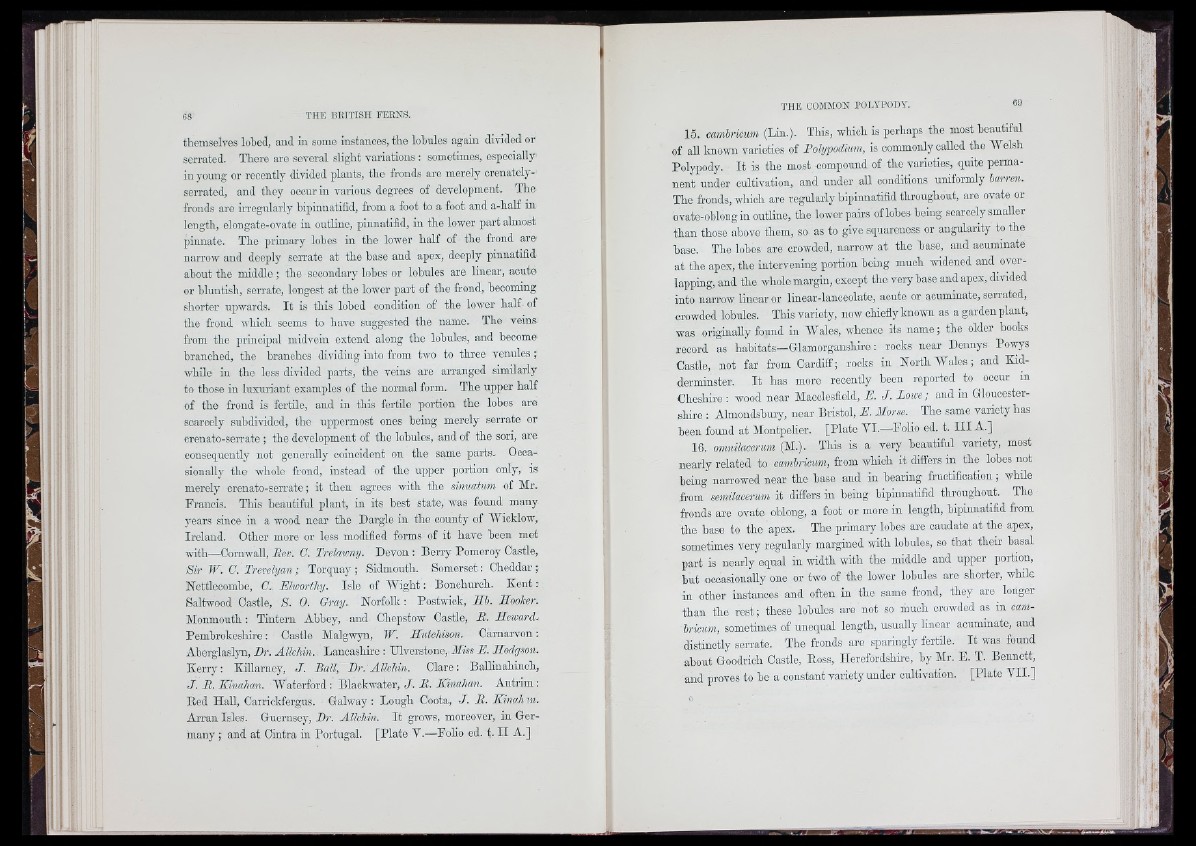
11 I
themselves lobed, and in some instances, the lobules again divided or
serrated. There are several slight variations : sometimes, especially
in j’oung or recently divided plants, the fronds aro merely crenately-
serratod, and they occur in various degrees of development. The
fronds aro irregularlj'’ hipinnatifid, from a foot to a foot and a-lialf in
length, elongate-ovate in outlino, pinnatifid, in the low’cr part almost
pinnate. The primary lobes in the lower half of the frond are
narrow and deeply serrate at the base and apex, deeply pinnatifid
about tlie middle ; tbe secondary lobes or lobules are linear, acute
or bluntisb, serrate, longest at the lower part of the frond, becoming
shorter upivards. I t is this lobed condition of the lower half of
the frond which seems to have suggested the name. The veins
from the principal midveiu extend along the lobules, and become
branched, tho branches dividing into from two to three venules;
while ill tho less divided parts, the veins are arranged similarly
to those in luxuriant examples of the normal form. The upper half
of tlie frond is fertile, and in this fertile portion the lobos are
scarcely subdivided, the uppermost ones being merely serrate or
crenato-serrate ; tlie development of tbe lobules, and of the sori, are
consequently not generally coincident on the same parts. Occasionally
the whole frond, instead of the upper portion only, is
merely crenato-serrate; it then agrees with the sinuatum of Mr.
Francis. This beautiful plant, in its hest state, was found many
j-ears since in a wood near the Dargle in the county of Wicklow,
Ireland. Other more or loss modified forms of it have been met
with—Cornw’all, Rev. C. Trelaimy. Devon : Berry Pomeroy Castle,
Sir W . C. Trevelyan; Torquay ; Sidmouth. Somerset; Cheddar ;
Nettleoombe, C. Ehcorthy. Isle of W ig h t; Bonchurch. K e n t:
Saltivood Castle, S. 0. Gray. Norfolk: Postwiok, Ilb . Hooker.
Monmouth: Tintern Abbey, and Chepstow Castle, R . Heward.
Pembrokeshire: Castle Malgwyn, W. Hutchison. Carnarvon:
Aberglaslyn, Dr. Allchin. Lancashire : Ulvcrstone, M'lss E. Hodgson.
K e rry ; Killarney, J. Ball, Dr. Allchin. Clare: Ballinahinoh,
J . B . Kinahan. Waterford: Blackw'ater, J . J?. Antrim:
Bed Hall, Cairiokfergus. Gahvay: Lough Coota, J . B . Hinah m.
Arran Isles. Guernsey, Dr. Allchin. I t grows, moreover, in Germany
; and at Cintra in Portugal. [Plate V.—Lolio ed. t. I I A.]
15. cambricum (Lin.). This, which is perhaps the most beautiful
of all known varieties of Polgpodiim, is commonly called the Welsh
Polypody. I t is the most compound of the varieties, quite permanent
under cultivation, and under all conditions uniformly barren.
The fronds, which are regularly hipinnatifid throughout, aro ovate or
ovate-ohlongin outlino, tho lower pairs of lohcs being scarcely smaller
than those above them, so as to give squareness or angularity to the
base. The lobes are crowded, narrow at tbe base, and acuminate
at the apex, the intervening portion being much widened and overlapping,
and the whole margin, except the very base and apex, divided
into narrow linear or linear-lanceolate, acute or acuminate, serrated,
crowded lobules. This variety, now chiefly known as a garden plant,
was originally found in Wales, whence its name; the older hooks
record as habitats—Glamorganshire : rooks near Dennys Powys
Castle, not far from Cardiff; rocks in North W a le s ; and Kidderminster.
I t has more recently been reported to occur in
Cheshire : wood near Macclesfield, E. J . Lowe; and in Gloucestershire
: Almoiidsbury, near Bristol, E. Morse. The same variety has
been found at Montpelier. [Plate V I.—Folio ed. t. I l l A.]
16. omnüacerum (M.). This is a very beautiful variety, most
nearly related to cambricum, from which it differs in the lobes not
being narrowed near the base and iu hearing fructification; while
from semilacerum it differs in being hipinnatifid throughout. The
fronds are ovate oblong, a foot or more in length, hipinnatifid from
tbe base to tbe apex. The primary lobes are caudate at the apex,
sometimes very regularly margined with lobules, so that their basal
part is nearly equal in width with the middle and upper portion,
but occasionally ono or two of the lower lobules are shorter, while
iu other instances and often in the same frond, they are longer
than the r e s t; these lobules are not so much crowded as in cam-
hricum, sometimes of unequal length, usually linear acuminate, and
distinctly serrate. The fronds aro sparingly fertile. I t was found
about Goodrich Castle, Ross, Herofordshiro, hy Mr. E. T. Bennett,
and proves to he a constant variety under cultivation. [Plate V II.]
■
I i
?»
■; 1
'.A
I il